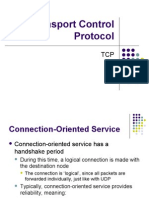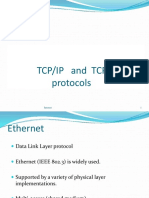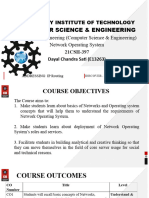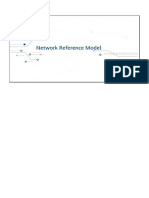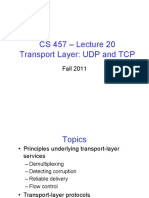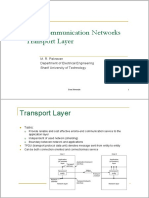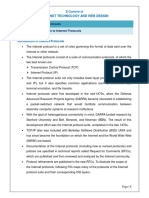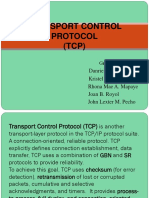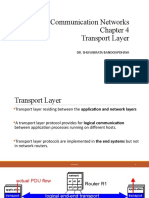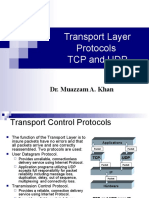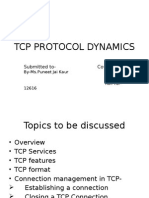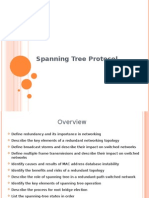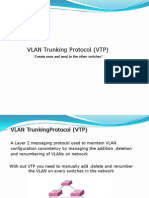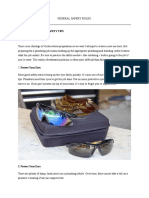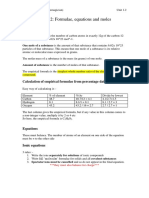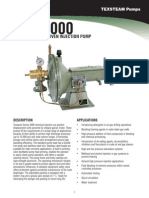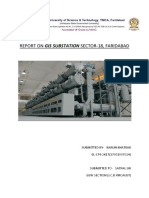TCP/IP Overview
The TCP/IP Model
The Department of Defense (DoD) developed the TCP/IP reference model to provide a communication network that could continue to function in war time.
�TCP/IP Applications
�Transport Layer Protocols
The functions of TCP and UDP
Segment upper-layer application data
�The Transmission Control Protocol
Each TCP/IP application typically chooses to use either TCP
or UDP based on the applications requirements. TCP provides error recovery, but it consumes bandwidth and uses more processing cycles. TCP relies on IP for end-to-end delivery of the data. Regardless of whether two computers are on the same Ethernet, or are separated by the entire Internet, TCP performs its functions the same way.
�TCP Header and Functions
Multiplexing using port numbers. Error recovery Flow control Connection establishment and termination End-to-end ordered data transfer Segmentation
�Multiplexing Using Port Number
The computer might be running many applications, such as a web browser, an e-mail package, or an FTP client. TCP and UDP both have a feature called multiplexing. TCP and UDP multiplexing enables the receiving computer to know which application to give the data to.
�Error Recovery (Reliability)
To accomplish error recovery, TCP numbers data bytes using Sequence and Acknowledgment fields in the TCP header.
The Sequence number reflects the number of the first byte in the segment.
The Acknowledgment number implies the next byte to be received; this is called forward acknowledgment.
�Error Recovery (cont)
If the second TCP segment is lost, the web client replies an ACK field equal to 2000, implying that the web client is expecting byte number 2000 next.
The TCP function at the web server then could recover lost data by resending the second TCP segment.
The TCP protocol allows for resending just that segment and then waiting, hoping that the web client will reply with an ack 4000.
�Positive ACK
With positive acknowledgment and retransmission (PAR), the source sends a packet, starts a timer, and waits for an acknowledgment before sending the next packet. If the timer expires before the source receives an acknowledgment, the source retransmits the packet and starts the timer over again.
�Flow Control Using Windowing
The Window field implies the maximum number of unacknowledged bytes allowed outstanding at any instant in time. The Window field is used by the receiver to tell the sender how much data it can send before it must stop and wait for the next acknowledgment. When there is no errors, the receiver grants a larger window to the sender. The window slides up and down based on network performance sliding window.
�Connection Establishment
SYN: Synchronize
ACK: Acknowledgment
TCP three-way connection establishment occurs before any of the other TCP features can begin their work. The connection exists between the two sockets. TCP initialises the Sequence Number and Acknowledgment Number fields to any number that fits into the 4-byte fields.
�Connection Termination
FIN: Finish
Before the device on the right sends the third TCP segment in the sequence, it notifies the application that the connection is coming down. It then waits on an akcnowledgment from the application before sending the third segment.
�Data Segmentation Ordered Data Transfer
Each different type of data link protocol typically has a limit on the maximum transmission unit (MTU) that can be sent. MTU refers to the size of the Layer 3 packet that sits inside the data field of a frame - the default MTU size is 1500 bytes. TCP handles the fact that an application might give it millions of bytes to send by segmentingthe data into smaller pieces, called segments. Because an IP packet can often be no more than 1500 bytes, and because IP and TCP headers are 20 bytes each, TCP typically segments large data into 1460 bytes (or smaller) segments. The TCP receiver performs re-ssembly when it receives the segments and it must reorder segments that arrive out of sequence. UDP push its data to the upper layer to be reordered by upper protocols
�The User Datagram Protocol
UDP is connectionless and provides no reliability, no windowing, and no reoredering of the received data. However, UDP provides data transfer, segmentation, and multiplexing using port numbers. The most advantage of UDP over TCP is that there are fewer bytes of overhead and it transfers data faster than TCP. UDP does not require waiting on acknowledgments or holding the data in memory until it is acknowledged.
�The
Internet Layer Protocols
IP Protocol is responsible for: defining packet format and addressing scheme routing packets to remote hosts transferring data between the internet layer and the network access layer
�Internet Layer Protocols
IP - connectionless, best-effort delivery routing of
packets.
ICMP - control and messaging capabilities.
ARP - determines the data link layer address for
known IP addresses. address.
RARP - determines the IP address for a known MAC
�Internet Control Message Protocols
Used for Error reporting & management purposes.
Described in RFC 792. Message types include
Destination Unreachable. Host Unreachable. Port Unreachable.
�Address Resolving using ARP
ARP request IP:150.151.10.6 MAC:?
IP:150.151.10.5 MAC: 00:F2:C3:43
IP:150.151.10.5
Resolves IP to Ethernet MAC addresses.
A router acts as a Proxy ARP
�Reverse ARP
RARP request MAC:00:F2:C3:43 What's my IP?
IP:150.151.10.5 MAC: 00:F2:C3:43
MAC:00F2:C3:43
Resolves Ethernet MAC addresses to IP. Commonly found is diskless workstations
�Network Access Protocols
The Network Access Layer is the host-to-network layer of the TCP/IP model.
Encapsulation of IP packets into frames Interface to the physical medium
��Comparing TCP/IP with the OSI Model


